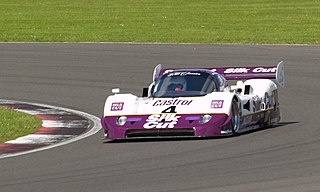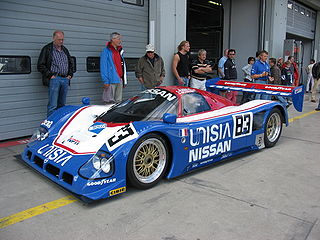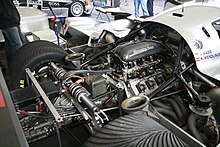
A flat-twelve engine, also known as a horizontally opposed-twelve, is a twelve-cylinder piston engine with six cylinders on each side of a central crankshaft.

Karl Wendlinger is an Austrian professional racing and former Formula One driver.

The Mazda 787 and its derivative 787B are Group C sports prototype racing cars that were developed by Japanese automobile manufacturer Mazda for use in the World Sportscar Championship, All Japan Sports Prototype Championship, and the 24 Hours of Le Mans from 1990 to 1991. Designed to combine a mixture of the Fédération Internationale du Sport Automobile (FISA) Group C regulations with the International Motor Sports Association (IMSA) GTP regulations, the 787s were the last Wankel rotary-powered racing cars to compete in the World and Japanese championships, using Mazda's R26B engine.

The Mercedes-Benz M119 is a V8 automobile petrol engine produced from 1989 through 1999. It was available in 4.2 L; 5.0 L; and 6.0 L displacements. It was a double overhead cam design with 4 valves per cylinder and variable valve timing on the intake side. It was replaced by the 3-valve M113 starting in 1997.

The Sauber C9 is a Group C prototype racing car introduced in 1987 as a continuation of the partnership between Sauber as a constructor and Mercedes-Benz as an engine builder for the World Sportscar Championship. The C9 replaced the Sauber C8.

The 1999 24 Hours of Le Mans was the 67th 24 Hours of Le Mans, and took place on 12 and 13 June 1999. The race had a large number of entries in the fastest Le Mans Prototype classes, with Audi, BMW, Ferrari, Lola Cars, Mercedes-Benz, Nissan, Panoz, Riley & Scott, and Toyota all represented.

The 1991 24 Hours of Le Mans was the 59th Grand Prix of Endurance, taking place at the Circuit de la Sarthe, France, on the 22 and 23 June 1991. It was also the fourth round of the 1991 FIA Sportscar World Championship season. This was the inaugural season of the new 3.5-litre non-turbo regulations for Sports Cars, however the number of teams entering cars in that class was very limited, so the entry list was opened up to the old Group C category. However, to promote their new formula, FISA decreed that the top ten grid spots had to be taken by cars in the new class, regardless of their qualifying time, with the Group C cars arranged behind them. The piston-engine Group C cars were penalised to carry 100 kg extra ballast, however the rotary-engine Mazdas were not. The race was anticipated to be a final showdown between Jaguar and Sauber-Mercedes, with Porsche, Mazda and the new Peugeots playing supporting roles. Indeed, from the front of the grid, the Peugeots did lead for the first hour, but their reliability failed them, and they were soon in the pits to eventually retire. It was then the Mercedes cars that took up the lead, even running 1-2-3 for several hours. The Jaguars were being stymied by fuel consumption and had to temper their pace accordingly. However, the three cars stayed in the top-10, fighting with the two new Mazda 787Bs.

The 1989 24 Hours of Le Mans was the 57th Grand Prix of Endurance, taking place at the Circuit de la Sarthe, France, on the 10 and 11 June 1989. This year it was not included as a round of the 1989 World Sports-Prototype Championship. The entry list promised a strong contest between five manufacturers. Jaguar had won in 1988 and went on to win the championship; while Sauber had finished second and was now matching Jaguar on the track. New regulations were coming in 1991, and the first examples of the 3.5-litre normally-aspirated formula were entered by Spice Engineering.

The 1988 24 Hours of Le Mans was the 56th Grand Prix of Endurance as well as the fifth round of the 1988 World Sports-Prototype Championship. It took place at the Circuit de la Sarthe, France, on the 11 and 12 June 1988. At their third attempt, Jaguar arrived with five cars to take on the strong Porsche works team of three cars, in their only race for the Championship season. The other potential rival was Sauber, now formally backed by Mercedes-Benz, but after a major high-speed tyre-blowout in practice, their two-car team was withdrawn.

Max Welti is a former Swiss racing driver, Sauber's first team manager and thus double winner of the 24 Hours of Le Mans as well as two-time sports car world champion with Sauber Mercedes. Five years later, he wins the 24 Hours of Le Mans for a second time with Porsche as the responsible race director. He then returns to Sauber as overall manager of the Sauber Formula One operation. In 2000 Welti becomes CEO of the European silhouette touring car racing series "V8STAR" before becoming team owner of A1 A1 Team Switzerland in 2005. As an international motorsport strategist and consultant, Welti nowadays works for OEMs, promoters and organisers.

The Mercedes-Benz CLK LM was a Group GT1 sports car designed and built by Mercedes-Benz in partnership with AMG to compete in the FIA GT Championship. To satisfy the requirements of competing in the FIA GT Championship, a road-legal version had to be built to homologate the car. That car was known as the Mercedes-Benz CLK LM Straßenversion, and Mercedes-Benz assembled two chassis, one of which was destroyed for crash-testing. The CLK LM went on to win every single championship event in the 1998 FIA GT season, retiring only at the 1998 24 Hours of Le Mans, which was a non-championship event. The removal of the GT1 class from the FIA GT Championship due to the lack of entrants and rising costs meant that Mercedes' GT1 program was brought to a close at the end of 1998. Mercedes instead focussed their efforts on the newly introduced LMGTP class for the 1999 season, which produced the Mercedes-Benz CLR.

The Jaguar XJR-14 is a sports-prototype racing car introduced for the 1991 World Sportscar Championship season. It was designed by Ross Brawn and John Piper, and was built and run by Tom Walkinshaw Racing (TWR), on behalf of Jaguar Cars.

The Mercedes-Benz C291 was a sports-prototype racing car introduced for the 1991 World Sportscar Championship season. It was Mercedes-Benz’ final car in the Group C category.

The Mercedes-Benz C292 was a stillborn Group C prototype race car intended for the 1992 World Sportscar Championship season as an evolution of the Mercedes-Benz C291, but never raced due to Mercedes-Benz withdrawing from sportscar racing after a dismal 1991 season.

The Sauber C8 was a Group C prototype race car introduced in 1985 for the 24 Hours of Le Mans as the first in a partnership between Sauber and Mercedes-Benz.
Throughout its long history, Mercedes-Benz has been involved in a range of successful motorsport activities, including sportscar racing, touring car racing, Grand Prix racing, and rallying. It is currently active in GT racing, and Formula One. Mercedes is also one of only three constructors to complete the Triple Crown of Motorsport, a feat that Mercedes achieved as both a chassis manufacturer and an engine manufacturer by winning the 1952 24 Hours of Le Mans.

The Jaguar XJR-11 was a sports-prototype racing car introduced for the 1989 World Sports Prototype Championship, while its sister car the XJR-10 was introduced to compete in IMSA series races.

The Nissan R90C was a platform used for Group C racing cars built in 1990 by Nissan Motors for competition in World Sportscar Championship (WSC) based in Europe and the All Japan Sports Prototype Championship (JSPC). The cars based on the basic R90C platform would compete until 1993 before Nissan chose to withdraw from sports car racing, not returning until 1997. It won three JSPC championships and several significant endurance races during its career.

The Mercedes-Benz C112 was an experimental mid-engine concept car built in 1991 by German automobile manufacturer Mercedes-Benz as a test bed, similar to the later versions of the C111. Despite using the same chassis code, it was not related to the W112 series of limousines and coupes of the 1960s. The C112 was intended to be the road-legal counterpart of the Sauber-built C11 Group C prototype race car developed for the 1990 World Sports-Prototype Championship.
The Mercedes-Benz M291 engine is a 3.5-liter flat-12 racing engine, designed, developed and produced by Mercedes-Benz, for their Group C racing program. It was introduced in 1991, along with their new Mercedes-Benz C291 prototype race car chassis.




















